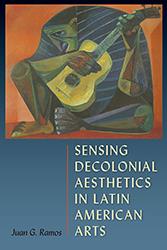Collective Creativity and Artistic Agency in Colonial Latin America
Edited by Maya Stanfield-Mazzi and Margarita Vargas-Betancourt
Hardcover: $80.00
Paper: $30.00
Paper: $30.00
Rethinking the role of the artist and recovering the work of unacknowledged creators in colonial society
“Important and well crafted. Reconsiders the notion of artist and artist’s biography as a technique of art historical research and analysis for the early modern Americas. The impact of this critical reframing should transcend Latin America itself, going beyond the region to reshape the ways in which art historians think about the idea of the artist in complex colonial situations where global forces and local histories conditioned one another for centuries.”—Paul Niell, author of Urban Space as Heritage in Late Colonial Cuba: Classicism and Dissonance on the Plaza de Armas of Havana, 1754-1828
“A first compilation of its kind, focused on how Indigenous artists made their different contributions to the region’s art history. This volume will impact undergraduates and graduate students alike, teaching them about ways to build an innovative narrative of colonial Latin American art.”—Rosario Inés Granados, Blanton Museum of Art, University of Texas at Austin
This volume addresses and expands the role of the artist in colonial Latin American society, featuring essays by specialists in the field that consider the ways society conceived of artists and the ways artists defined themselves. Broadening the range of ways that creativity can be understood, contributors show that artists functioned as political figures, activists, agents in commerce, definers of a canon, and revolutionaries.
Chapters provide studies of artists in Peru, Mexico, and Cuba between the sixteenth and early nineteenth centuries. Instead of adopting the paradigm of individuals working alone to chart new artistic paths, contributors focus on human relationships, collaborations, and exchanges. The volume offers new perspectives on colonial artworks, some well known and others previously overlooked, including discussions of manuscript painting, featherwork, oil painting, sculpture, and mural painting.
Most notably, the volume examines attitudes and policies related to race and ethnicity, exploring various ethnoracial dynamics of artists within their social contexts. Through a decolonial lens not often used in the art history of the era and region, Collective Creativity and Artistic Agency in Colonial Latin America examines artists’ engagement in society and their impact within it.
Maya Stanfield-Mazzi, professor of art history at the University of Florida, is the author of Clothing the New World Church: Liturgical Textiles of Spanish America, 1520-1820. Margarita Vargas-Betancourt is the Latin American and Caribbean Special Collections Librarian at the University of Florida.
Contributors: Derek S. Burdette | Ananda Cohen-Aponte | Emily C. Floyd | Aaron M. Hyman | Barbara E. Mundy | Linda Marie Rodriguez | Jennifer R. Saracino | Maya Stanfield-Mazzi | Margarita Vargas-Betancourt
Publication of this work made possible by a Sustaining the Humanities through the American Rescue Plan grant from the National Endowment for the Humanities.
- Sample Chapter(s):
- Excerpt
- Table of Contents
There are currently no reviews available












